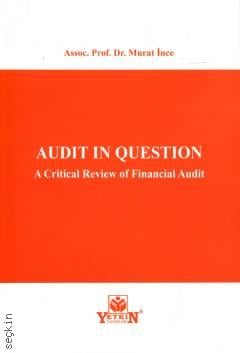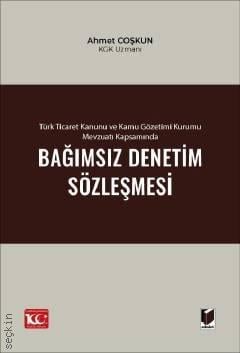
1. Baskı,
Temmuz 2024
Kitabın Detayları
Dili:
İngilizce
Ebat:
16x24
Sayfa Sayısı:
255
Kitabın Fiyatı:
400,00₺
Temin süresi 2-3 gündür.
Kitabın Açıklaması
This book presents a comprehensive critical analysis of the financial audit methodology applied by the four major accounting and audit firms that exert considerable influence over the global economy. It also offers a wide range of current suggestions, approaches and thoughts that are currently being discussed in the auditing world. A substantial proportion of the ideas and criticisms presented in the book are a reflection of the author's theoretical and practical knowledge in the field of auditing. The book commences with an ironic poem written in the 1930s, after which it proceeds to analyse the accounting scandals and auditing phenomenon from a variety of perspectives in the following four chapters. The final section of the book presents a thought-provoking analysis of the philosophy of auditing. The book concludes with a theatrical dialogue between the sophist and the auditor, which offers the general reader an insight into the philosophical, political and literary dimensions of the issues discussed.
Kitabın Konu Başlıkları

Accounting and–or Audit Scandals

Current Debates on Audit

Challenges in Implementing Intosai Auditing Standards and Proposed Solutions

On the Inconsistencies of Financial Audit
Kitapla İlgili Kategoriler
Yorumlar
Kitabın İçindekileri
CONTENTS
About the Author
11
FOREWORD
13
CHAPTER 1
ACCOUNTING AND/OR AUDIT SCANDALS
31
INTRODUCTION
31
1. The Relationship Between Accounting and Auditing
32
2. Some of the Top Accounting/Auditing Scandals of Our Time
35
2.1. Enron Scandal
36
2.2. WorldCom Scandal
41
2.3. Waste Management Scandal
43
2.4. Xerox Scandal
44
2.5. Satyam Scandal
45
2.6. Parmalat Scandal
46
2.7. Lehman Brothers Scandal
48
2.8. Wirecard Scandal
49
3. Regulations Made After the Scandals
51
3.1. International Regulatory Bodies and Standards
52
3.2. Sarbanes–Oxley (SOX) Act
58
3.3. Impact of Scandals on Independent Audit in Türkiye
62
4. Looking Behind the Scene: A Closer Look at the Wirecard Scandal
65
CONCLUSION
75
CHAPTER 2
CURRENT DEBATES ON AUDIT
77
INTRODUCTION
77
1. A Panoramic View of the Global Audit Industry
80
2. Is the Audit Really Independent?
89
3. Is Financial Audit a Sufficient Instrument to Prevent Scandals?
100
4. PCAOB’s Proposal: Non–Compliance with Laws and Regulations (NOCLAR)
103
5. Objections to PCAOB's Proposal
105
6. How Should We Understand the Strong Opposition to NOCLAR?
108
CONCLUSION
112
CHAPTER 3
CHALLENGES IN IMPLEMENTING INTOSAI AUDITING STANDARDS AND PROPOSED SOLUTIONS
115
INTRODUCTION
115
1. About INTOSAI
118
2. The INTOSAI Framework of Professional Pronouncements (IFPP)
121
3. Types of Public–Sector Audit and Basic Elements of Public–Sector Auditing
125
4. Challenges in Implementing INTOSAI Auditing Standards and Proposed Solutions
129
4.1. Financial Audit Standards
129
4.2. Compliance Audit Standards
138
4.3. Performance Audit Standards
144
CONCLUSION
150
CHAPTER 4
ON THE INCONSISTENCIES OF FINANCIAL AUDIT
157
INTRODUCTION
157
1. Philosophy of Financial Audit
160
2. Inconsistencies of Financial Audit
164
2.1. Repeatability and Efficiency Dilemma
165
2.2. The Challenge of Designing Audit Procedures in a Double–Entry Accounting System
170
2.3. The Challenge of Deriving Qualitative Results from Quantitative Analysis: Auditor's Responses to the Assessed Risks
178
2.4. The Conundrum in Calculating Audit Risk
184
2.5. Key Audit Matters: Towards Another Audit Type?
195
CONCLUSION
203
EPILOGUE: SOME REMARKS ON THE PHILOSOPHY OF AUDITING
209
A DIALOGUE ON THE RELEVANCE OF AUDIT
221
REFERENCES
241
Kitabın Fiyatı:
400,00₺
Temin süresi 2-3 gündür.
Bu kitaplar da ilginizi çekebilir
Sürdürülebilirlik Raporlarında Güvence Denetimi
Seval Selimoğlu, Serap Sebahat Yanık, Ayşe Banu Başar
Hakkımızda
|
Uluslararası Yayınevi Belgesi|
Kaynakça Dosyası|
Kişisel Verilerin Korunması |
Üyelik|
Siparişlerim|
İade Politikası|
İletişim


